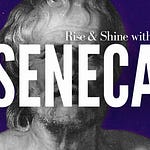This was the best airline layover of my life. I had the opportunity to travel to Austria for work and meet some of my colleagues there. The countryside, called Langenlois, west of Vienna, was beautiful. But I couldn’t fly directly back to Washington, D.C., and had to stay 18 hours in the United Kingdom. So instead of pouting about it or staying at the airport Hilton, I used the six hours available to visit the home, grave, church, and significant places of author
.We talk about Lewis a lot on Geeky Stoics. He was the most influential Christian apologist of the 20th century, author of The Chronicles of Narnia, The Space Trilogy, and The Screwtape Letters. His work has been valuable to me since I was very young, and that bond has only strengthened with time.
With the help of my local friend Mike—truly the finest Brit the King has on offer—I got a ride from the George Inn in Windsor up to Oxford.
The Kilns
We started with C.S. Lewis’s home, called The Kilns. About twenty minutes from the heart of the university and tucked into the back of a residential neighborhood, it's a beautiful cottage where Lewis lived much of his adult life as an Oxford academic and author.
A few residential scholars live in the home each year and manage its upkeep. It was the wrong day for a tour inside, but the groundskeeper let us into the yard and garden to walk around and see what Lewis’s exterior world was like.
I think about this stuff all the time. Aslan, Screwtape, Mere Christianity, and Miracles. Being in that place was remarkable.
Lewis once said,
“Aim at Heaven and you will get Earth ‘thrown in’,
aim at Earth and you will get neither.”
The Kilns is a place where someone was certainly aiming high.
C.S. Nature Reserve
Before leaving, there is a secluded path at the back of the house that leads to the publicly accessible C.S. Lewis Nature Reserve. It’s a wild place—loud with bird life but still quiet in the way a forest can be when it's so alive. The pond was coated in green, the brush was dense. A family of ducklings sat on a log in the water with their mother and didn’t budge as I sat nearby.
“Nature never taught me that there exists a God of glory and of infinite majesty. I had to learn that in other ways.
But nature gave the word glory a meaning for me.”
I could have stayed there for hours, but we didn’t have that kind of time. I had a flight to catch.
Before leaving the Kilns, I noticed the gardener had trimmed some weeds and flowers for disposal. I plucked the sweet-smelling top from one of the weeds most present at Lewis’s home—Canadian Goldenrod, I think.
Holy Trinity Church
Next was his resting site at Holy Trinity Church, a small Anglican church a few minutes away with no parking lot or car access that I could find. That added friction makes every visit a small pilgrimage—a minor act of rebellion against worldly convenience. We entered the grounds and took a few minutes to find his stone.
“Men must endure their going hence.” The same words that were on the calendar in his mother’s room when she died of cancer in 1908. A line from Shakespeare’s King Lear.
We will all die, though it’s the eternal project of mankind to avoid or obscure that fact. Who we are in life, I think, becomes part of who we are in death. Can you endure it, tolerate it, and welcome it with grace?
I left the goldenrod from Lewis’s garden there for him.
Inside the church, three older women were cleaning up. One was sprucing up a small C.S. Lewis dedication area, including stained glass with Narnia characters depicted on it. The church is still active for Sunday services.
You can also get a sense of Lewis’s view during sermons, which was not much of a view at all.
One of the women told us the plaque on the pew indicating his preferred seat was incorrect. I remembered this detail from his biography by Alister McGrath. Lewis preferred to sit behind a stone pillar so as not to offend the pastor with grimaces or looks of disagreement during sermons. Highly relatable, honestly. Lewis worked hard not to get caught up in being judgmental in church, resisting the use of such attitudes as a shield from engaging the material or the heart of the matter—something he satirizes in The Screwtape Letters.
Mike and I made a donation for a postcard and left for Oxford University’s Magdalen College, where Lewis was an influential and divisive instructor, largely due to his public popularity. Tall poppy syndrome, to be sure.
Oxford & Addison’s Walk
It's easy to see how Lewis made an exception for this place despite generally disliking England, at least in comparison to his birthplace in Northern Ireland.
We had lunch at The King’s Arms pub, picked up a few books at Blackwell’s, stopped by the lamppost said to have inspired the one in The Lion, the Witch and the Wardrobe, and visited Addison’s Walk—a nature path inside the college accessible for 10 euros.
Addison’s Walk is where Lewis came to once again believe in the divinity of Jesus Christ and the Christian faith, after a period of darker years marked by atheism. In 1931, he walked the path with J.R.R. Tolkien, who would soon publish The Hobbit, and Hugo Dyson. They persuaded Lewis that his love of pagan mythology, Greek goddesses, and Norse legends was part of how God prepared human hearts to receive a savior in Jesus of Nazareth. Lewis had always struggled to reconcile Christianity with the chaotic history of man’s many gods and stories.
This idea resonates with me as someone who wonders why stories like Lord of the Rings and Star Wars have always drawn me closer to God.
It’s because the creative act—even pagan art—is an expression of God-given yearning. The claim is that Christ redeemed these yearnings and fulfilled the myths we spent centuries crafting.
Lewis changed in these woods. I can’t put into words what it felt like to walk there with Mike, who also wanted to talk about God’s nature. It was one of the best experiences of my life.
Gratitude
The book my sister gave me years ago—Mere Christianity—which laid the intellectual foundation for Narnia, began here and found its fulfillment at the Kilns.
I’ve known Lewis since I was a child and got closer to his mind as a teenager with the renewed popularity of Narnia. But in this chapter of life, I feel I’ve come to know his heart.
While on this trip to Austria and the UK, I brought Letters from a Stoic by Seneca.
In it, Seneca says,
“Whoever says, ‘I have lived,’ receives a windfall every day
he gets up in the morning.”
I’m thankful for that day in Oxford. If I didn’t get another, it would have been enough.
“I’m goin’ nowhere you won’t find me”
Major shoutout to ℗ 2025 The Jazz Hop Café & Globetrotting Music Released for “Whispers of a home barely forgotten” the fantastic celtic lofi song











